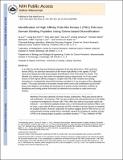Identification of High Affinity Polo-like Kinase 1 (Plk1) Polo-box Domain Binding Peptides Using Oxime-Based Diversification
Author(s)
Liu, Fa; Park, Jung-Eun; Qian, Wen-Jian; Scharow, Andrej; Berg, Thorsten; Lee, Kyung S.; Lim, Daniel Cham-Chin; Yaffe, Michael B; Burke, Terrence R.; ... Show more Show less
DownloadYaffe_Identification of high.pdf (2.148Mb)
PUBLISHER_POLICY
Publisher Policy
Article is made available in accordance with the publisher's policy and may be subject to US copyright law. Please refer to the publisher's site for terms of use.
Terms of use
Metadata
Show full item recordAbstract
In an effort to develop improved binding antagonists of the polo-like kinase 1 (Plk1) polo-box domain (PBD), we optimized interactions of the known high affinity 5-mer peptide PLHSpT using oxime-based post solid-phase peptide diversification of the N-terminal Pro residue. This allowed us to achieve up to two orders of magnitude potency enhancement. An X-ray crystal structure of the highest affinity analogue in complex with Plk1 PBD revealed new binding interactions in a hydrophobic channel that had been occluded in X-ray structures of the unliganded protein. This study represents an important example where amino acid modification by post solid-phase oxime ligation can facilitate the development of protein–protein interaction inhibitors by identifying new binding pockets that would not otherwise be accessible to coded amino acid residues.
Date issued
2012-01Department
Massachusetts Institute of Technology. Department of Biological Engineering; Massachusetts Institute of Technology. Department of Biology; Koch Institute for Integrative Cancer Research at MITJournal
ACS Chemical Biology
Publisher
American Chemical Society (ACS)
Citation
Liu, Fa, Jung-Eun Park, Wen-Jian Qian, Dan Lim, Andrej Scharow, Thorsten Berg, Michael B. Yaffe, Kyung S. Lee, and Terrence R. Burke. “Identification of High Affinity Polo-Like Kinase 1 (Plk1) Polo-Box Domain Binding Peptides Using Oxime-Based Diversification.” ACS Chemical Biology 7, no. 5 (May 18, 2012): 805–810.
Version: Author's final manuscript
ISSN
1554-8929
1554-8937